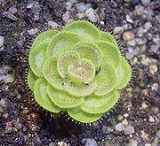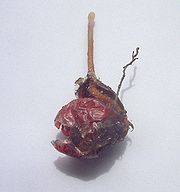
Drosera zonaria
Encyclopedia
Drosera zonaria, the painted sundew, is a perennial
tuber
ous species in the carnivorous plant
genus Drosera and is endemic to south-west Western Australia
from near Perth
southeast to near Esperance
. It grows in a tight rosette
approximately 5 to 7 cm in diameter with 20 to 30 green to red leaves that are arranged in concentric layers. The leaves are typically 1 cm wide and are usually described as being "kidney-shaped" with crimson leaf margins. It grows in deep silica sands in open woodland or coastal heathland
and only flowers after a bush fire, which is speculated to be caused by the release of ethylene
. Its white, sweetly perfumed flowers, which are very similar to those of D. erythrorhiza
, emerge on 4 to 5 cm tall scapes
. As with most other tuberous Drosera species, D. zonaria will die back during the dry summer months and retreat to the fleshy tuber
10 to 30 cm below ground.
 D. zonaria flowers so rarely that very few botanists have ever witnessed the event. It was first seen flowering in 1954, 106 years after it was formally described in 1848 by Jules Émile Planchon
D. zonaria flowers so rarely that very few botanists have ever witnessed the event. It was first seen flowering in 1954, 106 years after it was formally described in 1848 by Jules Émile Planchon
in Annales des Sciences Naturelles 9:303,1848. It was first collected near the Swan River Colony
by James Drummond
. Those specimens collected by Drummond were just two barren rosettes; later authors would try ascertain the proper species for these specimens. George Bentham
in 1864 questioned the species status of D. zonaria and suggested that the Drummond specimens might actually be examples of D. rosulata
. In the 1930s, both Ludwig Diels
and Charles Austin Gardner omitted this species name in their discussions of the genus. The type specimen
was even recorded under the name D. erythrorhiza
at Royal Botanic Gardens, Kew
. The species was finally rediscovered near Guildford
in 1952 by M. C. Russell, who then also saw it in flower for the first time in May 1954. By the time Rica Erickson
wrote her 1968 book Plants of Prey in Australia, no other flowering specimen of D. zonaria had been found.
Perennial plant
A perennial plant or simply perennial is a plant that lives for more than two years. The term is often used to differentiate a plant from shorter lived annuals and biennials. The term is sometimes misused by commercial gardeners or horticulturalists to describe only herbaceous perennials...
tuber
Tuber
Tubers are various types of modified plant structures that are enlarged to store nutrients. They are used by plants to survive the winter or dry months and provide energy and nutrients for regrowth during the next growing season and they are a means of asexual reproduction...
ous species in the carnivorous plant
Carnivorous plant
Carnivorous plants are plants that derive some or most of their nutrients from trapping and consuming animals or protozoans, typically insects and other arthropods. Carnivorous plants appear adapted to grow in places where the soil is thin or poor in nutrients, especially nitrogen, such as acidic...
genus Drosera and is endemic to south-west Western Australia
Western Australia
Western Australia is a state of Australia, occupying the entire western third of the Australian continent. It is bounded by the Indian Ocean to the north and west, the Great Australian Bight and Indian Ocean to the south, the Northern Territory to the north-east and South Australia to the south-east...
from near Perth
Perth, Western Australia
Perth is the capital and largest city of the Australian state of Western Australia and the fourth most populous city in Australia. The Perth metropolitan area has an estimated population of almost 1,700,000....
southeast to near Esperance
Esperance, Western Australia
Esperance is a large town in the Goldfields-Esperance region of Western Australia, located on the Southern Ocean coastline approximately east-southeast of the state capital, Perth. The shire of Esperance is home to 9,536 people as of the 2006 census, its major industries are tourism, agriculture,...
. It grows in a tight rosette
Rosette (botany)
In botany, a rosette is a circular arrangement of leaves, with all the leaves at a single height.Though rosettes usually sit near the soil, their structure is an example of a modified stem.-Function:...
approximately 5 to 7 cm in diameter with 20 to 30 green to red leaves that are arranged in concentric layers. The leaves are typically 1 cm wide and are usually described as being "kidney-shaped" with crimson leaf margins. It grows in deep silica sands in open woodland or coastal heathland
Heath (habitat)
A heath or heathland is a dwarf-shrub habitat found on mainly low quality acidic soils, characterised by open, low growing woody vegetation, often dominated by plants of the Ericaceae. There are some clear differences between heath and moorland...
and only flowers after a bush fire, which is speculated to be caused by the release of ethylene
Ethylene
Ethylene is a gaseous organic compound with the formula . It is the simplest alkene . Because it contains a carbon-carbon double bond, ethylene is classified as an unsaturated hydrocarbon. Ethylene is widely used in industry and is also a plant hormone...
. Its white, sweetly perfumed flowers, which are very similar to those of D. erythrorhiza
Drosera erythrorhiza
Drosera erythrorhiza, the red ink sundew, is a perennial tuberous species in the carnivorous plant genus Drosera that is endemic to Western Australia. It grows in a rosette and is distinguished from the other species in section Erythrorhiza by its many-flowered cymose inflorescences with up to 50...
, emerge on 4 to 5 cm tall scapes
Scape (botany)
In botany, scapes are leafless flowering stems that rise from the ground. Scapes can have a single flower or many flowers, depending on the species....
. As with most other tuberous Drosera species, D. zonaria will die back during the dry summer months and retreat to the fleshy tuber
Tuber
Tubers are various types of modified plant structures that are enlarged to store nutrients. They are used by plants to survive the winter or dry months and provide energy and nutrients for regrowth during the next growing season and they are a means of asexual reproduction...
10 to 30 cm below ground.

Jules Émile Planchon
Jules Émile Planchon was a French botanist born in Ganges, Hérault.-Biography:After receiving his Doctorate of Science at the University of Montpellier in 1844, he worked for a while at the Royal Botanical Gardens in London, and for a few years was a teacher in Nancy and Ghent...
in Annales des Sciences Naturelles 9:303,1848. It was first collected near the Swan River Colony
Swan River Colony
The Swan River Colony was a British settlement established in 1829 on the Swan River, in Western Australia. The name was a pars pro toto for Western Australia. In 1832, the colony was officially renamed Western Australia, when the colony's founding Lieutenant-Governor, Captain James Stirling,...
by James Drummond
James Drummond (botanist)
James Drummond was a botanist and naturalist who was an early settler in Western Australia.-Early life:...
. Those specimens collected by Drummond were just two barren rosettes; later authors would try ascertain the proper species for these specimens. George Bentham
George Bentham
George Bentham CMG FRS was an English botanist, characterized by Duane Isely as "the premier systematic botanist of the nineteenth century".- Formative years :...
in 1864 questioned the species status of D. zonaria and suggested that the Drummond specimens might actually be examples of D. rosulata
Drosera rosulata
Drosera rosulata is a perennial tuberous species in the genus Drosera that is endemic to southwest Western Australia. It grows in a rosette about 7 cm in diameter. It grows in sandy or clay soils on the margins of swamps. Its white flowers emerge in April to June. D. rosulata was first...
. In the 1930s, both Ludwig Diels
Ludwig Diels
Dr. Friedrich Ludwig Emil Diels , was a German botanist.Diels was born in Hamburg, the son of the classical scholar Hermann Alexander Diels. From 1900 to 1902 he traveled together with Ernst Pritzel through South Africa, Java, Australia and New Zealand. Shortly before the first world war he...
and Charles Austin Gardner omitted this species name in their discussions of the genus. The type specimen
Biological type
In biology, a type is one particular specimen of an organism to which the scientific name of that organism is formally attached...
was even recorded under the name D. erythrorhiza
Drosera erythrorhiza
Drosera erythrorhiza, the red ink sundew, is a perennial tuberous species in the carnivorous plant genus Drosera that is endemic to Western Australia. It grows in a rosette and is distinguished from the other species in section Erythrorhiza by its many-flowered cymose inflorescences with up to 50...
at Royal Botanic Gardens, Kew
Royal Botanic Gardens, Kew
The Royal Botanic Gardens, Kew, usually referred to as Kew Gardens, is 121 hectares of gardens and botanical glasshouses between Richmond and Kew in southwest London, England. "The Royal Botanic Gardens, Kew" and the brand name "Kew" are also used as umbrella terms for the institution that runs...
. The species was finally rediscovered near Guildford
Guildford, Western Australia
Guildford is a suburb of Perth, Western Australia, located 13 km northeast of the city. Its Local Government Area is the City of Swan.-History:Guildford was established in 1829 on the Swan River, being sited near a permanent fresh water supply...
in 1952 by M. C. Russell, who then also saw it in flower for the first time in May 1954. By the time Rica Erickson
Rica Erickson
Frederica Lucy "Rica" Erickson AM, née Sandilands, was an Australian naturalist, botanical artist, historian, author and teacher. Without any formal scientific training, she wrote extensively on botany and birds, as well as genealogy and general history...
wrote her 1968 book Plants of Prey in Australia, no other flowering specimen of D. zonaria had been found.

